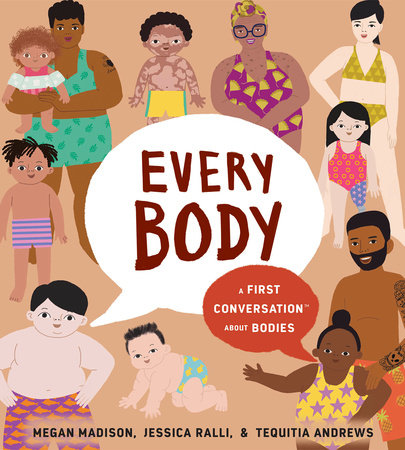Teach Your Child (and Yourself) To Love Every Body
by Elizabeth Harrison
I feel lucky that my childhood home did not focus on diet culture. However, I wasn’t immune to its influence in other spaces of my life, including the doctor’s office. As a teen, I remember caring too much about my BMI or Body Mass Index. I thought it was good that I was in the “Normal” range, right on the edge of Underweight. Only now, in my early 30s and on the opposite side of “Normal,” am I realizing how ridiculous and contrived the BMI system is.
Much of this newfound understanding is because of the book Every Body by Megan Madison, Jessica Ralli, and Tequitia Andrews. This newest addition to the First Conversations series introduces little ones to essential topics, including body diversity, disability justice, fatphobia, and body liberation.
The book begins: “I have a body. My body is awesome.” It then explains how everyone has a body, and there are many ways bodies can look. They are all special and deserving of care. The book teaches kids about the beauty and importance of fat, an often-stigmatized subject, explaining how it helps us store energy, which allows our bodies to do the things we love.
This title will help young readers realize their body’s power; it communicates what it needs and can even provide clues about our feelings. Like the other titles in this series, questions sprinkled throughout the pages encourage reflection and connection between grown-ups and children. Some questions include, “How does your body tell you what it needs?” and “How does your body feel right now?”

The bold and inclusive illustrations will appeal to young readers. As I read this with my three-year-old, she loved pointing out details in the pictures. For example, on the page about how our bodies change, she pointed at the baby pictures on the wall and connected them to her own baby pictures hanging in our family room. On the pages discussing disability and accommodations, she noticed the characters using wheelchairs and crutches, like other special people in her life.
I am grateful that more and more caregivers are seeing the importance of teaching kids about consent from a young age. This book encourages these conversations, reminding readers that their bodies belong to them and them alone. The verbiage modeled in the text can be easily brought into homes and used by grown-ups and kids alike.
While this entire book is powerful and important, the discussion on BMI is the most impactful. It begins, “But there’s a big problem. There are pictures and ideas all around us that say some bodies are healthier and more beautiful than all other bodies. That’s a lie people made up a long time ago.” Readers learn that BMI was established by a group of white men who decided being fat was bad and being skinny was good. These toxic ideas permeated our culture and still are very much present today, as evidenced by my adolescent experiences.

While these ideas certainly impacted my body image as a teen, they have been even more damaging toward fat people, who haven’t always received the care they need. The text teaches readers that there are people working hard to ensure that things become more fair for every body and invites readers to join these efforts.
I am grateful that my three-year-old will grow up with a more empowering view of her body and the bodies of others due to the ideas introduced in this book and reaffirmed in her daily life. She will grow up believing that every body is a good body and that ALL bodies can be healthy.

Available in board book and picture book format, Every Body offers caregivers language and background information (there’s lots of helpful back matter) they can use in conversations with their children. I truly believe that Every Body is as much for parents as for children. It is an essential title for every home.

